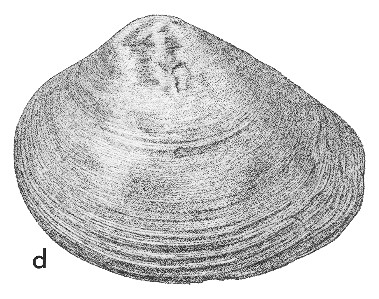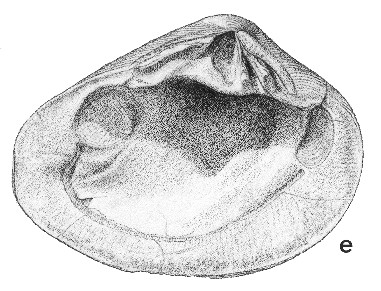
Revised descriptions of New Zealand Cenozoic Mollusca from Beu and Maxwell (1990)

 | Revised descriptions of New Zealand Cenozoic Mollusca from Beu and Maxwell (1990) | 
|
  (Pl. 12d): GS3600, F46/f8492, Mataura River, near Brydone, Southland, Waitakian (GNS) |
  (Pl. 12e): GS3600, F46/f8492, Mataura River, near Brydone, Southland, Waitakian (GNS) |
Beu & Maxwell (1990): Chapter 10; p. 146; pl. 12 d, e.
Synonymy: Crassatella ampla Zittel 1864, p. 46; C. attenuata Hutton 1873b, p. 24; Crassatellites attenuatus; Eucrassatella attenuata
Classification: Crassatellidae
Description: Large for genus (length 80-150 mm), thick-shelled, subtrigonal to oblong, length/height ratio 1.1-1.5, some shells almost equilateral, others strongly inequilateral. Posterior end truncate, posterior area flattened or slightly concave; umbonal ridge not well defined. Lunule large, strongly impressed; escutcheon well defined in right valve, transversely striate in well preserved shells, narrower and more obscure in left valve. Well preserved shells with rounded commarginal ridges on proximal few mm of umbones, remainder smooth except for growth lines. Hinge heavy, varying considerably in width, dominated by a deeply impressed triangular resilifer extending almost to ventral edge. Left valve with a low, finely rugose anterior lateral tooth, a thick anterior cardinal, a narrower median cardinal, and a prominent posterior lateral with a finely rugose socket above. Right valve with a shallow anterior lateral socket, a short anterior cardinal tooth, which is largely fused to lunule, and a heavy, triangular median cardinal; posterior lateral tooth formed by inner edge of escutcheon. Adductor muscle scars large, strongly impressed. Inner margins smooth.
Comparison: Eucrassatella ampla differs from E. australis (Pl. 5f, i) in its much larger size, its more weakly defined left escutcheon and in invariably having smooth internal margins. E. marshalli (Kapitean-Waipipian) is much smaller and has a less strongly impressed left escutcheon than E. ampla. E. scopalveus (see above under Spissatella) is much smaller than all other New Zealand species, and more nearly resembles Australian fossils such as E. kingicoloides (Pritchard) and E. camura (Pritchard) (Darragh 1965, pl. 14, figs. 23-26) than the other New Zealand fossils.
Eucrassatella apparently became extinct in New Zealand during the mid-Pliocene, but the extant Australian species are primarily inner-shelf dwellers that only rarely extend into deeper waters. E. ampla seems to have had a similar habitat.
Distribution: Duntroonian-Tongaporutuan; Cape Rodney, Auckland, Otaian (type locality of C. ampla); "Broken River" (type locality of C. attenuata, i.e. probably basal shellbed, Enys Formation, junction of Porter and Thomas River, Castle Hill Basin, Altonian), and numerous localities in North and South Islands.
Cite this publication as: "A.G. Beu and J.I. Raine (2009). Revised
descriptions of New Zealand Cenozoic Mollusca from Beu and Maxwell (1990). GNS
Science miscellaneous series no. 27."
© GNS Science, 2009
ISBN
978-0-478-19705-1
ISSN 1177-2441
(Included with a PDF facsimile file
copy of New Zealand Geological Survey Paleontological Bulletin 58 in CD version
from: Publications Officer, GNS Science, P.O. Box 30368 Lower Hutt, New
Zealand)